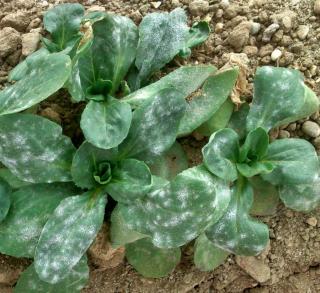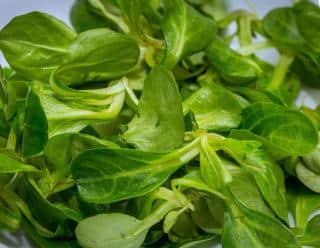

Corn salad is an easy type of salad green that is easy to grow, requires little space and is open to all, even if all you’ve got is a balcony or terrace.
Name – Valerianella olitoria
Family – Valerianaceae
Type – biennial
Height – 8 to 12 inches (20 to 30 cm)
Exposure – part sun
Soil – ordinary
Planting – August to October
Harvest – fall, winter, spring
Sowing, planting, caring for it and harvesting it will help you get great corn salad. Here is how to grow the queen of the winter greens!
Corn salad is sown in rows from August to October depending on the needs of the harvest.
When sowing end of August, you’ll harvest corn salad in fall whereas the last seeds sown in October will give you corn salad in the following spring.
1 – Hollow out small trenches (furrows) about ½ inch (one centimeter) deep.
2 – Space these furrows 8 to 10 inches (20 to 25 cm).
3 – Sow inside these furrows, and cover with a little soil mix or garden soil.
4 – Water regularly but not too much.
5 – As soon as the first leaves appear, thin to 3 to 4 inches (8 to 10 cm).
Also take note that it is very easy to grow corn salad in pots, containers or garden boxes so you can also produce some on your balcony or terrace.
Alternatively, simply broadcast corn salad seeds, taking great care to rake the area after sowing to bury the seeds.
After that, same as described earlier: water regularly and thin down to 3 to 4 inches (8 to 10 cm).
If you wish to avoid the seedling stage, it is often possible to purchase your corn salad in nursery pots with small leaves.
You can plant them in the ground, either in your vegetable patch or in a garden box on a terrace or balcony.
Corn salad is harvested when the leaf rosettes are well formed, around 3 months after sowing.
It is possible to harvest corn salad all winter long.
For that, select cold resistant corn salad varieties like ‘Ronde Maraîchère’, ‘Verte de Cambrai’, ‘Coquille de Louviers’, ‘Trophy’ or ‘Topaze’.
As soon as the cold hits, protect your seedlings and plants with a small greenhouse, a tunnel, or any other device that will help your corn salad grow even though temperatures are below freezing, providing as much light as possible.


Corn salad doesn’t deliver much energy, but contains high amounts of water and an excellent omega 3 ratio.
There are also many trace elements, fibers, minerals and vitamins that our bodies require.
In a nutshell, remember that corn salad is easy to grow and boasts high nutritional content: great assets for any gardener!
Even though it doesn’t keep very well, it still is possible to extend the shelf-life of corn salad a bit longer if you wrap it loosely in a cloth or plastic wrap and store it in the vegetable compartment of your refrigerator.
Stage sowing dates and varieties to produce corn salad for many long months.